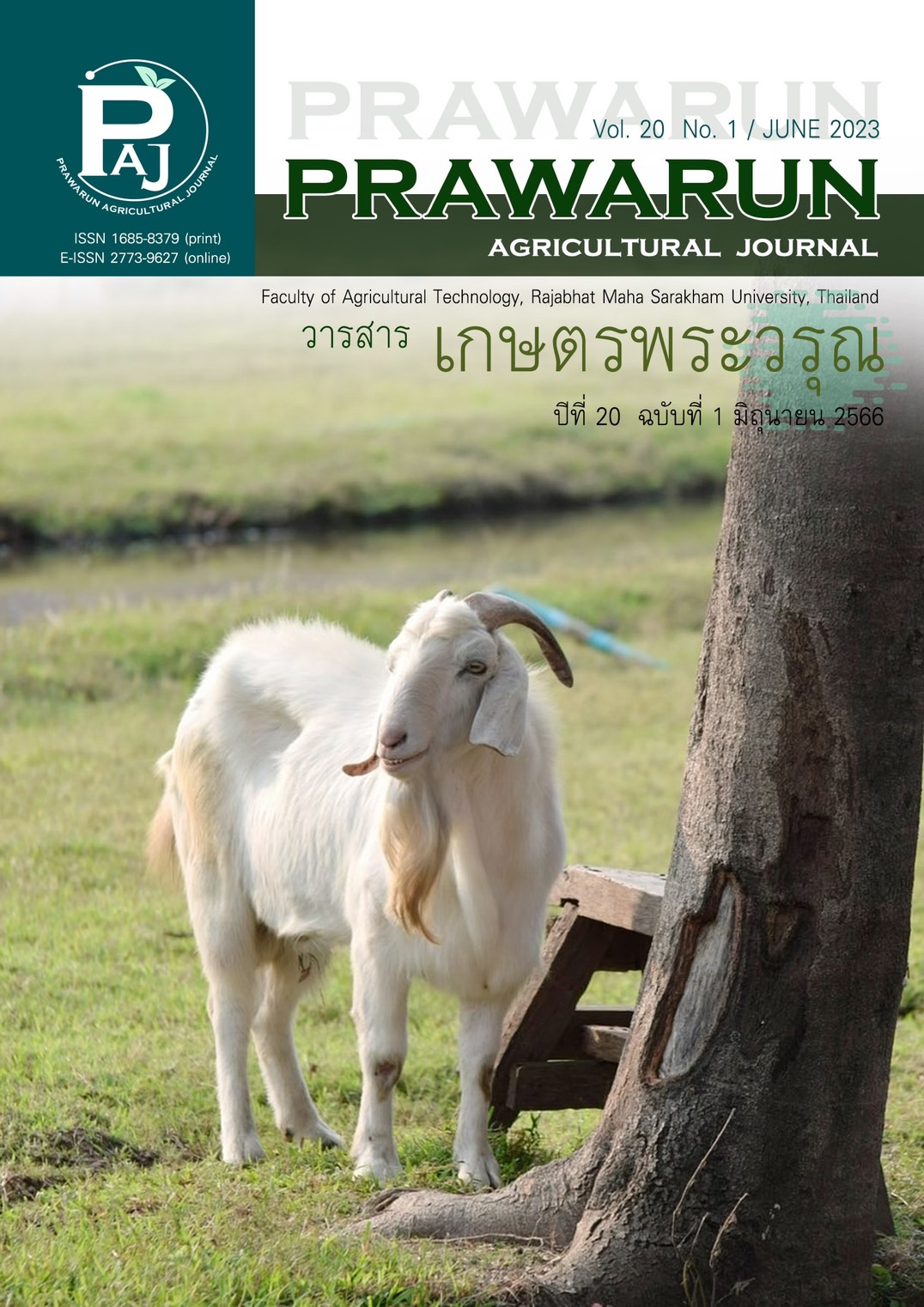การเปลี่ยนแปลงพารามิเตอร์การสังเคราะห์ด้วยแสงของอ้อยโคลนดีเด่นภายใต้สภาวะเครียดจากการขาดน้ำ
Main Article Content
บทคัดย่อ
การเปลี่ยนแปลงทางสรีรวิทยาเป็นหนึ่งในกระบวนการตอบสนองของพืชภายใต้สภาวะเครียดจากการขาดน้ำซึ่งรวมถึงค่า SPAD chlorophyll meter reading (SCMR) และค่าพารามิเตอร์การสังเคราะห์ด้วยแสง ดังนั้น การศึกษาในครั้งนี้จึงมีวัตถุประสงค์เพื่อศึกษาการเปลี่ยนแปลงค่าพารามิเตอร์การสังเคราะห์ด้วยแสงของอ้อยภายใต้สภาวะเครียดจากการขาดน้ำและหลังกลับมาได้รับน้ำอีกครั้ง โดยวางแผนการทดลองแบบ Split plot design in RCB จำนวน 3 ซ้ำ ประกอบด้วย 2 ปัจจัย ได้แก่ ปัจจัยหลัก คือ (1) การให้น้ำตามความต้องการของพืช และ (2) งดการให้น้ำนาน 14 วัน ที่อายุ 96 - 109 วันหลังปลูก (ระยะแตกกอ) และปัจจัยรอง คือ พันธุ์/โคลนอ้อยดีเด่น ได้แก่ (1) KK11-516 (2) KK14-030 (3) KK14-136 (4) LK92-11 และ (5) KK3 ดำเนินการทดลอง ณ ศูนย์วิจัยพืชไร่ขอนแก่น อำเภอเมือง จังหวัดขอนแก่น ปี พ.ศ. 2565 จากการศึกษาพบว่า เมื่อขาดน้ำ ค่า SCMR ของอ้อยจะมีค่าลดลง และเมื่อเปรียบเทียบระหว่างพันธุ์/โคลนพบว่า โคลน KK14-136 มีค่า SCMR สูงสุด ที่อายุ 139 วันหลังปลูก (หลังกลับมาได้รับน้ำนาน 30 วัน) มีค่าเฉลี่ยเท่ากับ 40.14 SPAD-unit ขณะเดียวกัน พบว่า เมื่อขาดน้ำค่าพารามิเตอร์การสังเคราะห์ด้วยแสงของอ้อยทุกพันธุ์/โคลนมีค่าลดลง แต่พบว่า โคลน KK14-030 มีค่าชักนำการเปิด-ปิดปากใบและการคายน้ำใกล้เคียงกับอ้อยที่ได้รับน้ำตามปกติ หลังได้รับน้ำอีกครั้ง นาน 1 วัน เท่ากับ 0.07 และ 2.16 mmol m-2s-1 ตามลำดับ ซึ่งผลการศึกษาในครั้งนี้ สามารถนำไปใช้เป็นแนวทางการศึกษาด้านพารามิเตอร์การสังเคราะห์ด้วยแสงของอ้อยหรือใช้ประกอบการคัดเลือกอ้อยพันธุ์ใหม่ในประเทศไทยในลำดับต่อไป
Article Details
เอกสารอ้างอิง
Aguilera, C., Stirling, C. M., & Long, S. P. (2002). Genotypic variation within Zea mays for susceptibility to and rate of recovery from chill-induced photoinhibition of photosynthesis. Physiologia Plantarum, 106(4), 429-436. doi.org/10.1034/j.1399-3054.1999.106411.x
Aidar, S. T., Meirelles, S. T., Oliveira, R. F., Chaves, A. R. M., & Fernandes-Júnior, P. I. (2014). Photosynthetic response of poikilochlorophyllous desiccation-tolerant Pleurostima purpurea (Velloziaceae) to dehydration and rehydration. Photosynthetica, 52(1), 124-133. doi:10.1007/s11099-014-0014-0
Buakom, W., KrachaI P., Gonkhamdee, S., Songsri, P., & Jongrungklang, N. (2020). Responses of rooting and physiological characteristics of sugarcanes grown under mimic drought stress as low water potential at early stage. Khon Kaen Agriculture Journal, 48(6), 1442-1457. doi:10.14456/kaj.2020.127
Chinnasaen, T., Cheakittisak, R., Jungpol, P., Chanachai, S., & Pakdeethai, C. (2021). Studies on agronomic traits and cane yield of sugarcane promising clones under irrigated and rain-fed conditions. Prawarun Agricultural Journal, 18(1), 17-26. doi:10.14456/paj.2021.2 (in Thai)
Da Graca, J. P., Rodrigues, F. A., Farias, J. R. B., De Oliveira, M. C. N., Hoffmann-Campo, C. B., & Zingaretti, S. M. (2010). Physiological parameters in sugarcane cultivars submitted to water deficit. Brazilian Journal of Plant Physiology, 22(3), 189-197. doi: 10.1590/S1677-04202010000300006
Da Silva, P. P., Soares, L., Da Costa, J. G., Da Silva Viana, L., De Andrade, J. C. F., Goncalves, E. R., Dos Santos, J. M., De Souza Barbosa, G. V., Nascimento, V. X., Todaro, A. R., Riffel, A., Grossi-de-Sa, M. F., Barbosa, M. H. P., Santana, A. E. G., & Neto, C. E. R. (2012). Path analysis for selection of drought tolerant sugarcane genotypes through physiological components. Industrial Crops and Products, 37(1), 11–19. doi : 10.1016/j.indcrop.2011.11.015
Dongsansuk, A. (2017). Physiological responses of plants to environments. Khon Kaen: Faculty of Agriculture Khon Kaen University. (in Thai)
Doorenbos, J., & Kassem, A.H. (1979). Yield response to water. Rome: Food and Agriculture Organization of the United Nations. doi:10.1016/B978-0-08-025675-7.50021-2
Field Crops Research Institute (FCRI). (1994). Field crops plantation. Bangkok: Field Crops Research Institute Department of Agriculture. (in Thai)
Jaiphong, T., Tominaga, J., Watanabe, K., Nakabaru, M., Takaragawa, H., Suwa, R., Ueno, M., & Kawamitsu, Y. (2016). Effects of duration and combination of drought and flood conditions on leaf photosynthesis, growth and sugar content in sugarcane. Plant Production Science, 19(3), 427–437. doi: 10.1080/1343943X.2016.1159520
Kasemsap, P. (2006). Biology 2. Bangkok: The project of science and mathematics book, the Promotion of Academic Olympiad and Development of Science Education Foundation. (in Thai)
Khonghintaisong, J., Songsri, P., & Jongrungklang, N. (2017). Growth and physiological patterns of sugarcane cultivars to mimic drought conditions in late rainy season system. Naresuan University Journal: Science and Technology, 25(2), 102-112.
Li, C., Nong, Q., Solanki, M. K., Liang, Q., Xie, J., Liu, X., Li, Y., Wang, W., Yang, L., & Li, Y. (2016). Differential expression profiles and pathways of genes in sugarcane leaf at elongation stage in response to drought stress. Scientific Reports. 6, 25698. doi: 10.1038/srep25698
Lisar, S. Y. S., Motafakkerazad, R., Hossain, M. M., & Rahman, I. M. M. (2012). Water stress in plants: Causes, effects and responses. Accessed February 2, 2023. Retrieved from https://www.researchgate.net/publication/221921924_Water_Stress_in_Plants_Causes_Effects_and_Responses
Liu, Y. Y., Li, J., Liu, S. C., Yu, Q., Tong, X. J., Zhu, T. T., Gao, X. X., & Yu, L. X. (2020). Sugarcane leaf photosynthetic light responses and their difference between varieties under high temperature stress. Photosynthetica, 58(4), 1009-1018. doi: 10.32615/ps.2020.038
Namwongsa, J., Jongrungklang, N., & Songsri, P. (2019). Genotypic variation in root distribution changes and physiological responses of sugarcane induced by drought stress. SABRAO Journal of Breeding and Genetics, 51(4), 470-493.
Paisancharoen, K., Sansayawichai, T., Luanmanee, S., Thippayarugs, S., Chusorn, K, Chuenrung, J., & Pakdeethai, C. (2012). Water requirement and Kc values of Khon Kaen 3 sugarcane variety. Khon Kaen Agriculture Journal, 40 (Suppl. 3), 103-114. (in Thai)
Ramesh, P. (2000). Sugarcane breeding institute, coimbatore, India effect of different levels of drought during the formative phase on growth parameters and its relationship with dry matter accumulation in sugarcane. Journal of Agronomy and Crop Science, 185(2), 83-89.
doi: 10.1046/j.1439-037x.2000.00404.x
Silva, M. De A., Jifon, J. L., Da Silva, J. A. G., & Sharma, V. (2007). Use of physiological parameters as fast tools to screen for drought tolerance in sugarcane. Brazilian Journal of Plant Physiology, 19(3), 193-201. doi: 10.1590/S1677-04202007000300003
Smith, M. (1992). CROPWAT- A computer program for irrigation planning and management. Rome: Food and Agriculture Organization of the United Nations.
Sun, J. K., Li, T., Xia, J. B., Tian, J. Y., Lu, Z. H., & Wang, R. T. (2011). Influence of salt stress on ecophysiological parameters of Periploca sepium Bunge. Plant, Soil and Environment, 57(4), 139–144. doi.org/10.17221/227/2010-PSE
Wang, J., Zhang, X., Han, Z., Feng, H., Wang, Y., Kang, J., Han, X., Wang, L., Wang, C., Li, H., & Ma, G. (2022). Analysis of physiological indicators associated with drought tolerance in wheat under drought and re-watering conditions. Antioxidants, 11(11), 2266. doi.org/10.3390/antiox11112266
Wolfe, D. W., Henderson, D. W., Hsaio, T. C., & Alvino, A. (1988). Interactive water and nitrogen effects on senescence of maize. II. Photosynthetic decline and longevity of individual leaves. Agronomy Journal, 80(6), 865-870.


